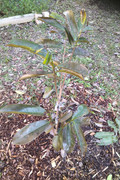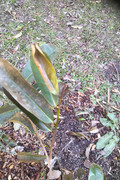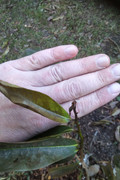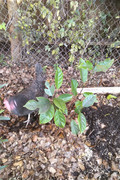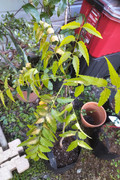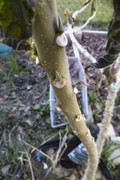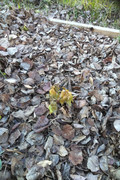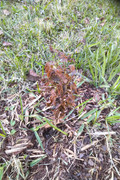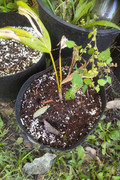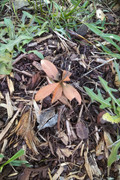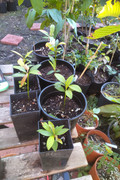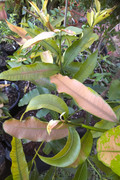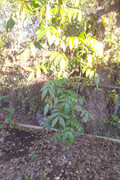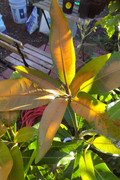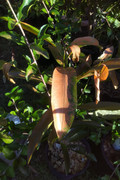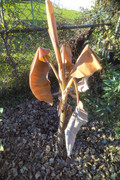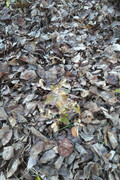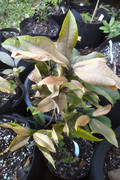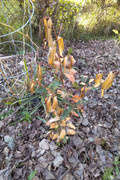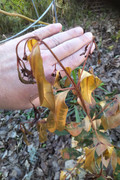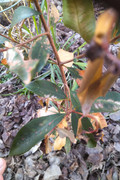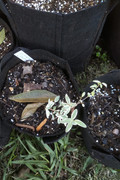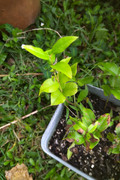Thank you to everyone with the patience for my listings-
I have finally been able to get my stuff together to a point I feel comfortable listing these plants for sale-
Shipping is not included in these prices and will be calculated on checkoutSince this auction is to fundraise for the effort described here-
https://tropicalfruitforum.com/index.php?topic=44362.25There will be two methods of payment
- Direct to me- will send address via PM
- Direct donation to the garden and send me a screenshot - Shipping needs to be sent to me
https://app.mobilecause.com/vf/give4andreas/DanielZamlerThe short list of whats for sale
Annona muricata - 5x in 4in starter -
$10 EachAnnona senegalensis - 8 5 4 2x in 4in starter - $20 eachAnnona squamosa cv. "Big Red" - 4 1x in 4in starter - $20 EachAnnona squamosa cv. "Na Dai" - 2x in 4in starter - $15 EachAnnona squamosa cv. "Thai Lessard" -
3 1x in 4in starter -
$15 EachArtocarpus dadah - 1x in 4in starter -
$30Artocarpus integer cv. "Sri gading" -
9 8x in ~1g pots -
$15 eachArtocarpus lacucha - 2 1x in 4in starter - $35 eachArtocarpus sericicarpus - 1x in 4in starter -
$30Baccaurea deflexa - 2x in 4in starter pots -
$20 eachBaccaurea pyriformis -
5 3x in 4in starter -
$20 EachBaccaurea ramiflora -
10 9x in 4in starter -
$15 EachBaccaurea spp. "Luwi" - 2x in 4in starter - $30 eachBouea macrophylla - 2x in 4in starter - $15 EachCommiphora mollis - 2x in 4in starter -
$20 EachDimocarpus longan cv. "White" -
6 5x in 4in starter -
$15 EachDovyalis caffra -
30 28 24x in 4 in starter -
$10 each !!!!!$5 when purchasing ANY other plant!!!!!Dovyalis longispina - 4x in 4in starter -
$20 eachEuclea divinorum -
10 8x in 4in starter -
$20 EachGarcinia brasiliensis - 1x in ~1gal pots - $15 eachGarcinia kola - 7x in 4in starter pots -
$30 EachLansium spp. "LongKong" -
23 22x in 4in Starters -
$20 eachLansium spp. "Paete" -
11 10x in 4in starters -
$25 EachMimusops zeyheri - 7 5 2x in 4in starter - $15 EachMondia Whitei -
40 39 37x in 4in starter -
$10 each !!!!!$5 when purchasing ANY other plant!!!!!Mystroxylon aethiopicum -
3 1x in 4in starter -
$15 eachPassiflora nitida - 4 2x in 4in starter - $10 eachPlinia aureana - 1x in 4in starter -
$15Plinia spp. "Campo de Ramon" - 1x in 4in starter -
$20Plinia spp. "Grimal" - 2x in 4in starter -
$20 EachPlinia spp. "Red" - 2x in 4in starter -
$20 Each Plinia cauliflora cv. "Sabara" - 9x in 4in starter -
$15 EachPsidium longipetiolatum - 2 1x in 4in starter - $15 EachRandia formosa -
26 25 24x 4 in starter -
$10 eachSaba senegalensis - 10x in 4in starter -
$25 EachVangueria infausta -
6 5 4x in 4in starter -
$30 eachPlants to be listed for auction soon-
Solanum oocarpum 1x
Virola surinamensis 1x
So far our donors include-
Pokeweed
mikesid
brian
aka_no_nui193
TropicalDoc
555
Bradholc
Itay Gazit
Brian laufer
Madridje
thornable
Piss P
Dirt Diva
W.
JoeP450
sooperkenIf anyone wants more info or pictures of the plants for sale please see below, I will try to upload the missing pictures by the end of the day
Annona muricata - “Soursop”
The sour sop is a fast-growing, small, evergreen tree that can reach a height of about 7 metres. The bole can be up to 15cm in diameter, generally branching from near the base.
The tree is widely cultivated in tropical regions for its edible fruit. It was one of the first fruits carried from the Americas to the Old World tropics and now it is widely distributed in Asia from S India to N Australia and Polynesia, and in Africa in the hot lowlands in the west and east. Fruit - raw or cooked. Juicy and refreshingly acid. The fruit has a pineapple like aroma, but its subacid to acid flavour is unique and the pulp is very juicy and rich in vitamin A and C. The fruits are consumed fresh for dessert when fully ripe or mixed with ice cream or milk to make a delicious drink. Immature fruits, harvested when the seeds are still soft, are cooked as a vegetable in soups etc. The most desirable characteristics of the fruit are its extremely pleasing fragrance and flavour. The ovoid fruit contains many seeds; it is up to 20 x 10cm, and can weigh 1 kilo.
Young shoots - cooked. Eaten as a vegetable.
A tea, called corossol tea, is made from the leaves.
Sour sop is often used in traditional medicine. Research has shown that it is antimalarial, uterine stimulant, anticrustacean, antiparasitic, cytotoxic (acetogenins), cardiac depressant, antiamoebic, antibacterial, antifungal, hypertensive, spasmogenic, vasodilator, insecticide, smooth muscle relaxant. Text sourced from tropical.theferns.info5x in 4in starter -
$10 Each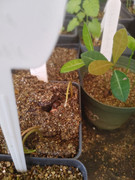
Annona senegalensis - “Wild Custard Apple”
Annona senegalensis is usually a multi-stemmed deciduous shrub growing 2 - 6 metres tall, but in favourable conditions, especially in east Africa, it can become tree-like and as much as 11 metres tall.
A multi-purpose tree providing food, medicine and a range of commodities for the local people. The plant is not generally cultivated, but is often gathered from the wild. The fruit is sometimes sold in local markets. The plant is said to have the potential for domestication. Fruit - raw. The edible white pulp of the ripe fruit has a pleasant, pineapple-like aroma with the flavour of apricots. The yellow to orange fruit is around 5cm in diameter.
The leaves are sometimes used as vegetables. The dried leaves contain 8.2% protein. The flowers serve as a spice for various meals. The unopened flower buds are eaten in soups and used as a flavouring.
Text sourced from Cite as: Tropical Plants Database, Ken Fern. tropical.theferns.info. 2021-09-11. <tropical.theferns.info/viewtropical.php?id=Annona+senegalensis>8x in 4in starter -
$20 each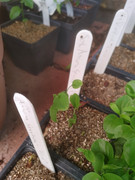
Annona squamosa cv. "Big Red" - “Sugar Apple”
4x in 4in starter -
$20 Each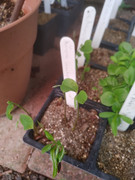
Annona squamosa cv. "Na dai" - “Sugar Apple”
2x in 4in starter -
$15 Each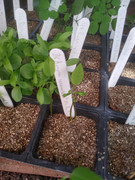
Annona squamosa cv. "Thai lessard" - “Sugar Apple”
The custard apple is an attractive, slow-growing deciduous shrub or small tree with a rounded or spreading, open crown. It reaches a height of 3 - 6 metres.
A very popular fruit, the tree is widely cultivated in tropical and subtropical areas around the world for its edible fruit. It is commonly sold in markets. Fruit - raw. The sweet and creamy fruits are highly regarded as a dessert fruit. They can also be used to make sherbet, ice cream, jellies etc. The fruit is up to 10cm in diameter The bark and leaves, combined with those of Annona muricata, are used in a sedative infusion.3x in 4in starter -
$15 Each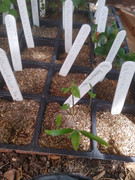
Artocarpus dadah - “Tempang”
Artocarpus dadah is a deciduous tree that can grow up to 35 metres tall. The straight, cylindrical bole can be up to 60cm in diameter.
The tree is commonly exploited from the wild for its timber, which is traded internationally. T is also harvested from the wild for local use as a food and medicine. Fruit - an acid flavour. The fruit is about the size of a chicken's egg. The fruit is up to 5cm in diameter. Text sourced from Cite as: Tropical Plants Database, Ken Fern. tropical.theferns.info. 2021-09-11. <tropical.theferns.info/viewtropical.php?id=Artocarpus+dadah>1x in 4in starter -
$30
Artocarpus integer cv. "Sri gading" -
Average size fruit (2 kg) with green skin color and orange flesh that tastes very sweet. according to https://doa.sarawak.gov.my/page-0-0-124-Cempedak.html9x in ~1g pots - $
15 each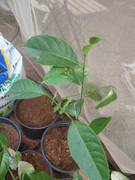
Artocarpus lacucha - “Lakoocha”
Lakoocha is a deciduous tree with a dense, spreading crown; it can grow 6 - 18 metres tall.
The plant is valued mainly for its edible fruit, which is often gathered from the wild, and also supplies medicines and various materials for local use. The tree is sometimes cultivated for its fruit in the tropics of the Old and New Worlds, especially in northern India, the fruit often being sold in local markets. The tree is also sometimes grown as an ornamental, providing beneficial shade.
In many places within its native range the populations are gradually decreasing due to extensive exploitation and poor seed viability.
The fruit has a pleasant sub-acid flavour. Occasionally eaten raw, they are more commonly used in curries and chutneys. The fruit is up to 7.5cm long.
The male inflorescence is acid and astringent. It is sometimes pickled. Used as a component of some curry mixtures.
The broad, flat seeds are edible.
The bark contains 8 - 9% tannin and is chewed as a substitute for betel nut (Areca spp.). The bark is sometimes added to the betel mix
Text sourced from Cite as: Tropical Plants Database, Ken Fern. tropical.theferns.info. 2021-09-11. <tropical.theferns.info/viewtropical.php?id=Artocarpus+lacucha>2x in 4in starter -
$35 each
Artocarpus sericicarpus - “Pedalai”
Pedalai is a very large, evergreen rainforest tree that can grow 35 metres or more tall.
The fruit is esteemed locally and is often gathered from the wild. The tree is cultivated in the Philippines for its edible fruits. Fruit - raw. Sweet, juicy and aromatic. The sweet, creamy flesh is easy to eat, with the segments clinging to the central core when the skin is removed. The round, bright orange fruit is similar to the marang (A. odoratissimus), but has a superior flavour with a firmer flesh, slightly larger segments with less aroma. Seed - boiled, roasted or fried. Considered to be one of the tastiest seeds of plants in this genus. Text sourced from Cite as: Tropical Plants Database, Ken Fern. tropical.theferns.info. 2021-09-11. <tropical.theferns.info/viewtropical.php?id=Artocarpus+sericicarpus>1x in 4 in starter -
$30
Baccaurea deflexa - “Tampoi merah”
Baccaurea deflexa is a shrub or tree with a dense crown growing from 6 - 25 metres tall. The bole, which occasionally has buttresses up to 1 metre tall, can be 10 - 70cm in diameter. Although we have no specific record of edibility for this species, the fruits of all members of this genus are said to be edible, with a flavour that can be acid to sweet. The ellipsoid fruit is up to 15mm long and 14mm wide. Text sourced from Cite as: Tropical Plants Database, Ken Fern. tropical.theferns.info. 2021-09-11. <tropical.theferns.info/viewtropical.php?id=Baccaurea+deflexa>2x in 4in starter pots -
$20 each
Baccaurea pyriformis - “Keliwetn”
Baccaurea pyriformis is a tree with a dense crown growing 7 - 30 metres tall. The bole is 8 - 50cm in diameter, small buttresses are sometimes present. The edible fruit is harvested from the wild for local use. Fruit - raw. The pear-shaped fruits are up to 38mm long and 34mm wide. Dioecious.
Text sourced from Cite as: Tropical Plants Database, Ken Fern. tropical.theferns.info. 2021-09-11. <tropical.theferns.info/viewtropical.php?id=Baccaurea+pyriformis>5x in 4in starter -
$20 Each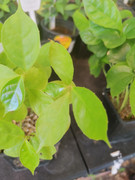
Baccaurea ramiflora - “Burmese Tree Grape”
Burmese grape is an evergreen tree with a dense, spreading crown; usually growing 10 - 15 metres tall but exceptionally up to 25 metres. The usualy crooked bole, which can be up to 40cm in diameter, sometimes has buttresses.
The tree is valued locally for its edible fruit and is often cultivated in the home garden and intercropped with other tropical fruits like durian, rambutan, and mango. It is also planted as an ornamental and to provide shade.
The fruit is used as a refreshing nibble or as table fruit. The pulpy, yellow aril is somewhat acid with an agreeable taste. To consume the fruit one is advised to break the fruit open with the fingers and/or peel the skin. The pulp is then eaten directly and usually the seeds are also swallowed. Eating more than small quantities may cause vomiting. The glabrous fruits are 25 - 30mm in diameter. They can be of various colours from yellowish, pinkish to bright red.
The leaves and flowers are sometimes eaten.
Text sourced from Cite as: Tropical Plants Database, Ken Fern. tropical.theferns.info. 2021-09-11. <tropical.theferns.info/viewtropical.php?id=Baccaurea+ramiflora>10x in 4in starter -
$15 Each
Baccaurea spp. “Luwi”
The sweetest Baccaurea. Common name: Luwi. Text sourced from the man himself! Maryoto2x in 4in starter -
$30 each
Bouea macrophylla - “Gandaria”
Gandaria is a large, evergreen tree with very dense foliage, growing up to 27 metres tall. The bole can be 55cm in diameter.
The fruit is very popular in parts of southeastern Asia and shows promise for greater commercial production. An attractive tree that provides excellent shade, it is widely cultivated for its fruit and as an ornamental in some areas of Thailand, Sumatra, Java and Borneo.
Fruit - raw or cooked. A juicy flesh with a variable flavour ranging from sour to sweet, with a characteristic faint smell of turpentine. The best forms are sweetish-sour and are eaten raw. The skin is usually removed when eating the fruit raw, but there is at least one cultivar where the skin is good to eat. Other forms are more acid and are used in cooking as a substitute for tamarinds or sour lime. The yellow to orange subglobose fruit is 25 - 50mm in diameter.
The use of the young fruits is more important; they serve as an ingredient of a special kind of 'sambal', the chilli-based condiment, and in pickles - the bright purple cotyledons in the big seed adding to the attraction of the concoction.
Leaves - raw. Eaten with rice. Occasionally the young leaves - which are deep violet, sometimes strikingly white when they emerge - are consumed fresh, to be eaten with the gandaria-flavoured 'sambal'. Text sourced from tropical.theferns.info2x in 4in starter -
$15 Each
Commiphora mollis - “Velvet Myrrh”
“Velvet commiphora” A tree growing to 8 metres. Dark greenish to grey bark. Grey-green leaflets. Small yellowish-pinkish flowers from Spring to Summer. Velvety fruit. Approximately 25 seeds per packet. Sow in Spring. USDA Zone 10. Text sourced from https://silverhillseeds.co.za/product/commiphora-mollis/?v=7516fd43adaa2x in 4in starter -
$20 Each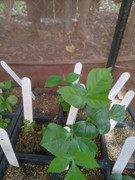
Dimocarpus longan cv. "White"
Commonly known as the longan (/ˈlɒŋɡən/), is a tropical tree species that produces edible fruit. It is one of the better-known tropical members of the soapberry family (Sapindaceae), to which the lychee, rambutan, guarana, korlan, pitomba, guinep and ackee also belong. The fruit of the longan are similar to that of the lychee, but less aromatic in taste. It is native to tropical Asia and China. The longan (from Cantonese lùhng-ngáahn 龍眼, literally 'dragon eye'), is so named because it resembles an eyeball when its fruit is shelled (the black seed shows through the translucent flesh like a pupil/iris). The seed is small, round and hard, and of an enamel-like, lacquered black. The fully ripened, freshly harvested fruit has a bark-like shell, thin, and firm, making the fruit easy to peel by squeezing the pulp out as if one were "cracking" a sunflower seed. When the shell has more moisture content and is more tender, the fruit becomes less convenient to shell. The tenderness of the shell varies due to either premature harvest, variety, weather conditions, or transport/storage conditions. Longan is commonly found in traditional Eastern folk medicine. This is a common occurrence since, prior to the 1800s, longan was most prevalent in Asia. In ancient Vietnamese medicine, the "eye" of the longan seed is pressed against snakebites to absorb the venom. This was ineffective, but is still commonly used today.6x in 4in starter -
$15 Each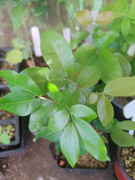
Dovyalis caffra - Kei Apple “Umkolo”
The plants contain prominent spikes on the branches. For the most part, both male and female plants are required for fruit set. There are some female trees that will bear without a male. Trees exhibit allelopathy and will inhibit the growth of other plants nearby. Fruiting is generally very intense, with fruits lining the branches for several months during the summer. A subtropical shrub or tree, capable of surviving temperatures to 20F. Kei apple's are both drought and salt tolerant and are often used as coastal landscaping shrubs. Fruits are often sprinkled with sugar and eaten fresh. They can also be used in a variety of desserts. Text sourced from tropical.theferns.info30x in 4 in starter -
$10 each !!!!!$5 when purchasing ANY other plant!!!!!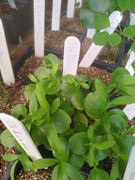
Dovyalis longispina - “Coastal Kei Apple”
“Coastal kei-apple” Medium tree in coastal scrub. Edible orange to red fruit. Slender spines to 8cm, shiny dark green leaves. Tiny white flowers during Spring. Sow in Spring. USDA Zone 10. Text sourced from https://silverhillseeds.co.za/product/dovyalis-longispina/?v=7516fd43adaa4x in 4in starter -
$20 each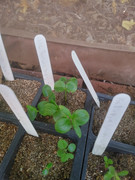
Euclea divinorum “Magic Guarri”
Ebenaceae. South African shrub or small tree to 25′. Smooth gray bark and green leathery leaves. Tiny white flowers in dense heads, small round edible fruits. The root bark has a variety of uses: to treat headache and epilepsy, an important source for brown dye, pieces are chewed for dental care and made into an effective mouthwash. Euclea are known to be burned and the smoke inhaled for divinatory purposes. Knick and soak seed overnight, sprouts in 2-6 weeks. A good bonsai subject. Z9a-b. Text sourced from sacredsucculents.com10x in 4in starter -
$20 EachGarcinia brasiliensis - “Superior Lemon Drop Mangosteen, Bacupari”
Garcinia brasiliensis is a pyramidal, very attractive, evergreen tree with a dense, rounded crown; it can grow 4 - 13 metres tall. The cylindrical bole can be 20 - 30cm in diameter.
The tree is highly valued for its edible fruit, which is gathered from the wild and consumed locally. It is often cultivated for its edible fruit in Brazil, especially in home gardens.
Garcinia brasiliensis has a very wide distribution, large population, is not currently experiencing any major
threats and no significant future threats have been identified. The plant is classified as 'Least Concern' in the IUCN Red List of Threatened Species(2019)
Fruit - raw. The aril-like translucent subacid white pulp has an excellent flavour, suggesting that of the mangosteen. A highly prized fruit, usually eaten fresh but also makes an excellent jam. The ovate fruit may be 32 - 40mm long, with an orange-yellow, pliable, leathery, tough skin, 3 mm thick that is easily removed.
Text sourced from Cite as: Tropical Plants Database, Ken Fern. tropical.theferns.info. 2021-09-11. <tropical.theferns.info/viewtropical.php?id=Garcinia+brasiliensis>2x in ~1gal pots -
$15 each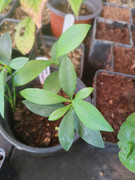
Garcinia kola - “Bitter Kola”
Garcinia kola is an evergreen tree, with a heavy, spreading crown, that can grow up to 30 metres tall, but is more usually around 12 - 15 metres.
A multipurpose tree and an important plant in the local economy. The tree is often found cultivated around villages. The seeds are sold in local markets and occasionally exported to ethnic populations living abroad. Bundles of pencil-sized wood are commonly sold in local markets for use as chew sticks. The seeds are an important article of commerce being traded well beyond the distribution area of the tree.
The tree has been classified as 'Vulnerable' in the IUCN Red List of Threatened Species(2004) due to general habitat loss and felling of the trees to provide chewsticks for dental hygiene. Seed - raw. They have a bitter, astringent, aromatic flavour; somewhat resembling that of a raw coffee bean. This is followed by a slight sweetness (or lingering pepperiness). The seeds are chewed along with the seeds of the true cola (Cola spp.). They are thought to enhance a person's enjoyment of the cola as well as allowing for consumption of larger quantities without indisposition.
The extremely sour fruits are sometimes eaten. They are orange-sized, and contain a yellow pulp surrounding four seeds. Bitter kola is widely used in traditional medicine in Africa with most parts of the plant being used and a wide range of ailments being treated.
Text sourced from Cite as: Tropical Plants Database, Ken Fern. tropical.theferns.info. 2021-09-11. <tropical.theferns.info/viewtropical.php?id=Garcinia+kola>7x in 4in starter pots -
$30 Each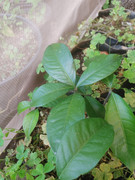
Lansium spp. "LongKong" -
Longkong is the fruit produce of the Lamyai tree, and is mainly grown in the North of Thailand, in the regions of Chiang Mai, Chiang Rai and Chiang Dao. Longkong requires a somewhat cooler climate than most other fruits found in Thailand, and these mountainous areas are always much cooler than the South.
The dark outer skin is almost crispy, and is easy to remove by pushing a thumbnail through and simply peeling it off. The inner flesh of the Longkong is white, almost translucent, and very soft. The taste of Longkong is very similar to the taste of a lychee, in fact, both fruits are comparable in almost every way, although a fully ripe Longkong is somewhat sweeter than a lychee.23x in 4in Starters -
$20 each
Lansium spp. "Paete" -
'Paete' is a leading cultivar in the Philippines.11x in 4in starters -
$25 Each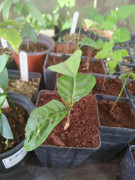
Mimusops zeyheri “Mmupudu” “Moepel” “Red Milkwood”
Sapotaceae. Evergreen tree to 50′. Leathery simple leaves. Clusters of small fragrant white flowers. Bright yellow to orange edible fruit, sweet and floury, high in vitamin C. Seed from South Africa. The spreading crown of the tree provides shade and would make an excellent edible ornamental. Thought to have been an important food source in antiquity and believed to have potential for development into a commercial fruit crop. Z9b/10a Text Sourced from sacredsucculents.com 7x in 4in starter -
$15 Each
Mondia whitei - “Whites Ginger”
Mondia whitei is a climbing shrub with a large, tuberous rootstock, producing stems usually up to 8 metres long but exceptionally to 20 metres.
A multipurpose plant harvested from the wild for local use, it is especially valued for its medicinal virtues, particularly as an aphrodisiac, but is also as a food, drink, source of fibre and tooth cleaner. The plant is sometimes cultivated in home gardens and is often sold for medicinal purposes and as a vegetable in local markets.
The fresh or dried leaves are cooked, sometimes with peanut butter, and eaten as a vegetable.
The dried powdered leaves are added to food as a condiment. The vanilla-like odour may have potential as a novel African fragrance or spice.
The fruits are considered edible in some parts of Africa, although in southern Africa the seeds are used as an arrow poison.
The roots are used to flavour food and tea. They are also used to make an energizing drink for wedding parties and a ginger-like beer.
Text sourced from Cite as: Tropical Plants Database, Ken Fern. tropical.theferns.info. 2021-09-11. <tropical.theferns.info/viewtropical.php?id=Mondia%20whitei>40x in 4in starter -
$10 each !!!!!$5 when purchasing ANY other plant!!!!!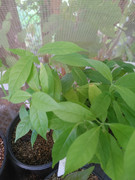
Mystroxylon aethiopicum “Kooboo Berry”
Celastraceae. Evergreen shrub to small tree with leathery simple leaves. Axillary clusters of small yellow-green scented flowers and 1/2″+ pink-red to purple edible fruit with a sweet-tart flavor. Native to the bushveld and forests of southern Africa. Root bark used for dysentery, the hard wood for tool handles and firewood. Makes a nice edible ornamental, fruits when small. Drought hardy and tolerant of some frost. Z9a/b. Text Sourced from sacredsucculents.com3x in 4in starter -
$15 each
Passiflora nitida - “Maracuja suspiro”
Passiflora nitida is a very vigorous climbing plant with a perennial rootstock. It produces annual to perennial stems from 8 - 15 metres long that scramble over the ground or clamber into other plants, supporting themselves by means of tendrils. In dense forest it climbs into the canopies of trees, only flowering when it reaches the light.
The edible fruits are greatly appreciated within the plant's native range, where it is collected from the wild and also sometimes cultivated. The plant is also cultivated in Indonesia (Java) for its tasty fruits.
Fruit - raw or used to make juices. The thick-skinned fruit has a juicy pulp with a sweet flavour. Tasty. The fruit is a globose berry about 3 - 6cm in diameter. The ellipsoid to widely ellipsoid (or obovoid), yellow-orange to red or dark purplish-red fruit can be 6 - 11cm × 5 - 8cm.
Text sourced from Cite as: Tropical Plants Database, Ken Fern. tropical.theferns.info. 2021-09-11. <tropical.theferns.info/viewtropical.php?id=Passiflora+nitida>4x in 4in starter -
$10 each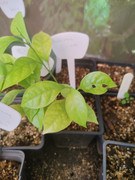
Plinia aureana - “Jaboticaba branca”
Jaboticaba branca is a semi-deciduous small tree with a short, crooked bole and dense, pyramidal crown; it can grow 2 - 7 metres tall.
The edible fruit is greatly appreciated locally. Not very common in the wild, the tree is often cultivated for its fruit in domestic orchards in southern Brazil. Fruit - raw. A succulent, sweet, pleasant-tasting pulp. The fruit is about 25mm in diameter. Text sourced from Cite as: Tropical Plants Database, Ken Fern. tropical.theferns.info. 2021-09-11. <tropical.theferns.info/viewtropical.php?id=Plinia+phitrantha&redir=Plinia+aureana>1x in 4in starter -
$15Plinia spp. cv. "Campo de Ramon"
1x in 4in starter -
$20
Plinia spp. cv. "Grimal"
1x in 4in starter -
$20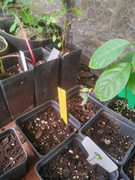
Plinia spp. cv. "Red"- “Jaboticaba”
Red is thought to be a cauliflora x aureana cross that is early bearing2x in 4in starter -
$20 Each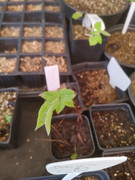
Plinia cauliflora cv. "Sabara"- “Jaboticaba”
Jaboticaba is a very slow-growing ornamental evergreen shrub or small tree with a dense crown, that can grow from 3 - 10 metres tall. It has one or more trunks and the branches emerge close to the ground and spread to give a dense, wide, round and symmetrical crown.
A highly esteemed fruit in Brazil, where the plant is often cultivated in domestic orchards. The fruit is often found for sale in local markets.The fruit can be eaten raw, made into jellies, syrups and preserves or fermented into wine. The purplish, grape-like fruit has a thick skin with a translucent, juicy pulp and a pleasant vinous flavour. In both taste and appearance they are remarkably like some cultivars of the muscadine grape. The fruit is rich in vitamin C. The shining-black, globose fruit is up to 35mm in diameter. The jam is marketed in Brazil as 'Brazilian Grape Jelly'.
Text sourced from Cite as: Tropical Plants Database, Ken Fern. tropical.theferns.info. 2021-09-11. <tropical.theferns.info/viewtropical.php?id=Plinia+cauliflora>9x in 4in starter -
$15 Each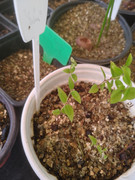
Psidium longipetiolatum - “Arazá serrano, Mountain Cherry Guava”
We’re excited to introduce a rare and unusual guava relative we’re calling Mountain Cherry Guava. Taxonomically known as Psidium longipetiolatum, Mountain Cherry Guava is a montane and cold hardy cousin to the more common Strawberry Guava. Native to high elevations in Brazil and Argentina, this large shrub or small tree produces a golf ball sized, aromatic fruit with a bold flavor. With thick and waxy evergreen leaves, the Mountain Cherry Guava is an attractive, cold hardy plant that should tolerate moderate frosts. Similar to Strawberry Guava, the fruit is high quality, having smaller and fewer seeds than the true Guava, with a fruity, berry flavor and pear-like texture. Cold hardy to zone 8b and above, or to 15 degrees Fahrenheit. Text sourced from https://www.wanderlustnursery.com/shop/products/p/mountain-cherry-guava2x in 4in starter -
$15 Each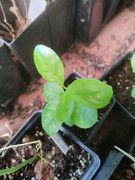
Randia formosa - “Blackberry Jam Fruit”
Randia formosa is an unarmed, widely branched, deciduous shrub or small tree usually growing about 4 metres tall.
The edible fruits are gathered from the wild for local use. The plant is sometimes grown as an ornamental, valued for its fairly large, fragrant and ornate white flowers.
Fruit - raw or cooked. Eaten fresh or used to make jams, jellies, preserves and beverages. The sweet tasting fruits have a hard yellow shell containing a dark black pulp. They are said to have a flavour like molasses or blackberry jam. The subglobose fruits are about 3cm x 2cm.
Text sourced from Cite as: Tropical Plants Database, Ken Fern. tropical.theferns.info. 2021-09-11. <tropical.theferns.info/viewtropical.php?id=Rosenbergiodendron+formosum&redir=Randia+formosa>26x 4 in starter -
$10 each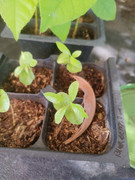
Saba senegalensis
Saba senegalensis varies in habit according to habitat. In open, drier lands it remains a lowly shrub, but when growing in forest it becomes a stout climbing shrub that can produce stems over 40 metres long by 47 cm girth.
The fruit is highly prized and, in parts of Africa, they are important to the rural economy, and many are trucked or carried in baskets to sell in the cities. The plant is also very ornamental and so is often grown as an edible ornamental in the garden. The plant is believed to have medico-magical attributes and is often preserved on the outskirts of villages.
The leaves are prepared in sauces and condiments as an appetizer with a salty tang.
The fruit has a soft, edible pulp with a sweet-sour flavour. The yellowish, ovoid fruit is about 7 cm long by 8 cm diameter. It is much prized and, besides the medico-magical attributes of the plant, is a very good reason for the conservation of the liana in the vicinity of villages. Most fruits about the size of a medium to small orange. In taste, they are acidic, almost like a strange form of citrus, which they nearly match in vitamin C content. They are full of big seeds that are coated with an aromatic sweet and sour flesh. Most are eaten as casual snacks, but some are employed even as a staple, especially during the rainy season. They are also blended with water and sugar and made into fruity beverage
Text sourced from Cite as: Tropical Plants Database, Ken Fern. tropical.theferns.info. 2021-09-11. <tropical.theferns.info/viewtropical.php?id=Saba+senegalensis>10x in 4in starter -
$25 Each
Vangueria infausta
Vangueria infausta is a deciduous shrub or small tree with a short bole, often with multi-stems, growing 1.5 - 8 metres tall. A tree of the subtropics to tropics, usually growing in areas with a distinct dry season at elevations up to 1,500 metres.
The edible fruit is one of the most popular wild foods in Tanzania. It is usually harvested from the wild for local use and sometimes also sold in local markets. The plant also has a range of local medicinal uses. The plant is often retained when land is cleared for cultivation and is sometimes cultivated as a fruit crop and ornamental.
Fruit - raw. A soft, fleshy pulp. An acid, somewhat sweetish-sour flavour. The brown pulp round the seeds tastes somewhat like stewed dried, apple-rings. The pulp is sometimes soaked in water and then dried for later use. The green fruit usually ripens to a dull orange-brown or purplish colour. It is 15 - 47mm in diameter. Seeds - raw. They can also be made into a relish
Text Sourced from Cite as: Tropical Plants Database, Ken Fern. tropical.theferns.info. 2021-09-11. <tropical.theferns.info/viewtropical.php?id=Vangueria+infausta>6x in 4in starter -
$30 each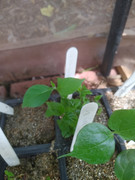
Cheers!






















































